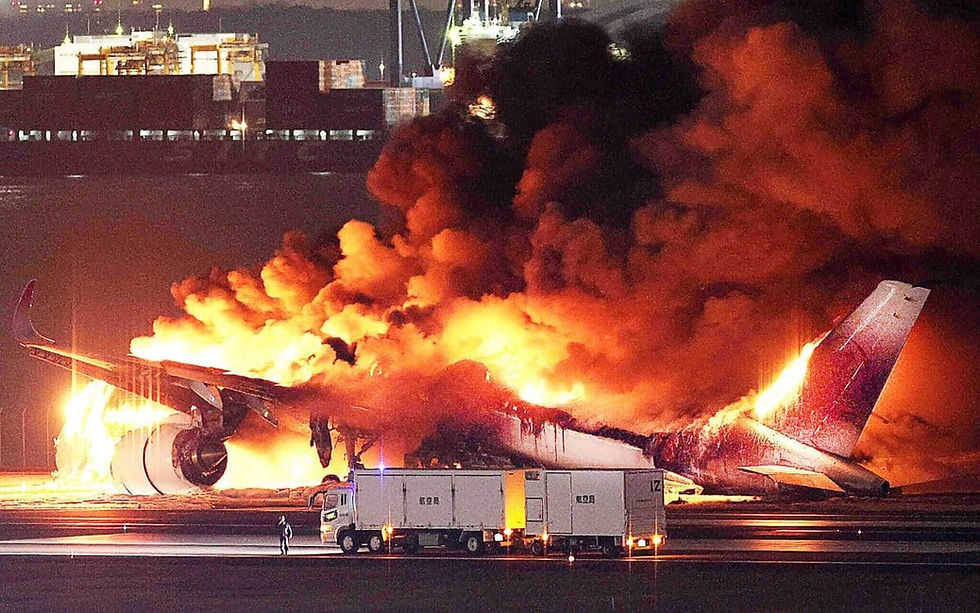Challenges in the Flammability of Composite Materials in Aircraft: A Call for Evolution in Standards and Testing
- Ormity Inc.
- Nov 17, 2025
- 5 min read
Aviation is one of the most demanding and regulated areas in terms of safety. The topic of flammability of materials in aircraft assumes critical relevance in this context, with rigorous regulations and tests establishing standards to guarantee the integrity and safety of passengers and crew. This article explores the specific challenges faced in the flammability of composite materials, highlighting the importance of testing and standards, with an emphasis on the recent incident involving an Airbus A350 in Japan. Throughout this analysis, an in-depth look will be taken at key tests, international standards relevant issues and the particular challenges associated with flammability in modern aircraft.

International Standards and Aeronautical Regulations: The aviation materials/components chain, as well as other sectors, is governed by a series of international standards established by renowned bodies, such as IEC (International Electrotechnical Commission ), UL (Underwriters Laboratories), ASTM (American Society for Testing and Materials), and DIN (Deutsches Institut für Normung - German Institute for Standardization). Each of these organizations presents specific requirements, which are also essential to ensure the fire resistance of materials used in aircraft.
IEC (International Electrotechnical Commission) | |
IEC 60695-11-5: Flammability test methods for electrical materials. | |
IEC 60335-1: Safety of household appliances - Part 1: General requirements. |
UL (Underwriters Laboratories) | |
UL 94: Test methods for flammability of plastic materials. | |
UL 746A: Standards for polymers used in electrical equipment. |
ASTM (American Society for Testing and Materials) | |
ASTM E1354: Radiant Heat Burn Test for Materials. | |
ASTM D635: Flammability Testing of Plastics Using the Flame Test Method. |
DIN (Deutsches Institut für Normung - German Institute for Standardization) | |
DIN 4102: Flammability test methods for building materials and building components. |
These standards are applicable in different sectors, and their observance is essential in aviation, as they guarantee the fire resistance of materials used in aircraft. In addition to these, there are specific regulations in the aviation sector that cannot be ignored, and their guidelines must be considered in a complementary way to the general rules. Industry regulatory agencies, such as the FAA (Federal Aviation Administration), play a crucial role in establishing specific regulations aimed at aviation safety and compliance. The relationship between international technical standards and specific aviation regulations is vital to guarantee the integrity and safety of aircraft.
Composite Materials and Development: The fire resistance of materials is a crucial issue in the aviation industry, especially considering the increasing use of composite materials, such as those prevalent in the fuselage of the Airbus A350. The V0 classification, standardized and described by bodies such as UL, ADSM and IEC, establishes strict standards, but the recent occurrence in Japan raises questions about the real effectiveness of these classifications. For example, tests such as HB, VB, GWFI and GWIT from IEC60695 2/12 and 2/13 are essential for evaluating the spread of flames and the reaction of materials in critical situations. The V0 flammability index classification and this classification is described by the standards applicable to flammability tests. Furthermore, IEC60112 should also be considered as the basis of this flammability analysis.
Material Comparison: Considering the melting point of aluminum and the glass transition temperatures (Tg) of resins used in carbon fiber composites, it is possible to address the concern regarding extreme temperatures.
Material | Melting Point/Tg (°C) |
Aluminum (typical alloy) | ~660 |
Carbon Fiber (CFRP) | ~2500-3000 (resin dependent) |
Composite Resin (Tg) vs. Extreme Temperature: | |
Epoxy | ~120-200 |
Phenolic | ~100-150 |
Polyester | ~50-80 |
Point of Concern: When considering applications in extreme temperature environments, it is crucial to evaluate the resin used in the carbon fiber composite. If the service temperature significantly exceeds the glass transition temperature (Tg) of the resin, the composite's mechanical properties may be lost, compromising its structural integrity. Therefore, the choice of materials for applications in extreme temperatures must be carefully evaluated, taking into account not only the mechanical properties of the carbon fiber, but also the thermal characteristics of the resin to ensure the desired performance in adverse conditions.
Challenges and Next Steps: Composite materials offer significant benefits in terms of weight and strength, but the incident in Japan highlighted the challenges intrinsic to these materials in fire situations. The complex interaction between components, especially in accident scenarios, requires a holistic understanding of the behavior of these materials. The balance between innovation and safety becomes crucial, encouraging the search for advances in flammability research.
Undoubtedly, there is nothing to discuss when comparing resistance, weight reduction and environmental impact when comparing composite materials in relation to aeronautical aluminum alloys. The point is: can it be improved? Of course, and this will be part of the research in the search for more appropriate resins and/or chemical retardants.
Next Steps Resulting from this New Fact: As the aeronautical industry advances, it is essential that standards and tests keep up with this progress. Aviation safety is an ongoing commitment, and evolving standards are vital to address emerging challenges. This incident in Japan serves as a call to action for a more comprehensive assessment of the aviation supply chain, instigating deeper studies into the actual behavior of composite materials in critical situations.
Conclusion and Call to Action: Aviation safety is an unquestionable priority, and the flammability of materials on aircraft is a central aspect of this equation. The recent incident highlights the need for thorough analysis, pushing the industry to rethink approaches and improve existing standards. In the midst of this crucial dialogue, voices of technicians experienced in designing equipment for flammability testing, as well as users of this equipment in everyday laboratory situations, become even more significant through existing committees and those to be created on this specific topic. .
V0 Classification and its Limits: The V0 classification is assigned to materials that have high resistance to the spread of flames. However, it is crucial to highlight that this classification does not mean absolute incombustibility. The V0 classification establishes limits for the spread of flames and extinguishing time, but extreme situations, such as those observed in the mentioned accident, can challenge the resistance of the materials.
Challenges in the Flammability of Composite Materials: Composite materials, although they offer significant benefits in terms of weight and strength, present specific challenges in fire situations. The aircraft fuselage is a complex interconnection of components, each subject to different fire exposure conditions. A complete understanding of the behavior of these materials under real conditions is essential.
Need for In-depth Studies in the Supply Chain: The case of the JAL plane highlights the importance of more in-depth studies in the aeronautical supply chain. It is essential to analyze the interaction of different materials in accident scenarios, considering not only the intrinsic resistance to fire, but also the joint response of all components.
Final Conclusion and Call for Continued Innovation: The conclusion highlights the continued importance of advances in flammability research, drawing attention to the need for more comprehensive assessments and case studies. Aviation safety is a constant commitment, and the evolution of standards and testing is crucial to face unforeseen challenges, such as the recent accident in Japan.





Comments